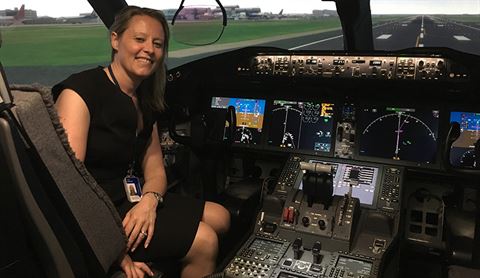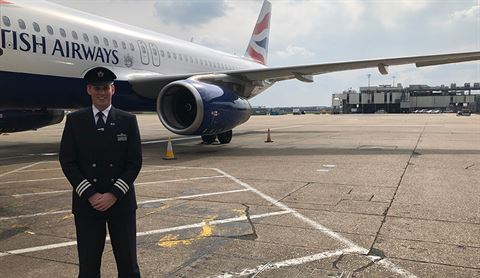BA PEOPLE • November 2022
How to become a British Airways pilot
Ever wondered what it takes to become a British Airways pilot? Senior First Officer Jai Dillon and talent acquisition manager Lucy Silvester give us the lowdown on how to gain your wings
Let’s start at the beginning, Jai. Why did you want to become a pilot?
I caught the flying bug on a Britannia flight to Mallorca when I was four or five years old. Back then, passengers were still able to visit the flight deck, and one of the cabin crew asked whether I wanted to go to see the pilots. I didn’t need to be asked twice. I came back and told my parents that one day I would be a pilot.
And how long have you been flying now?
I’ve been an airline pilot for ten years but have been flying for much longer. My parents paid for a trial lesson when I was 12 and then I went on to join the RAF Air Cadets when I was 13 and started my airline pilot training after finishing my A-levels. In the last decade, I’ve clocked up more than 7,000 flying hours – about 3,500 average short-haul flights.
And we thought we were frequent fliers! So, Lucy, how did you become part of the pilot recruitment team?
I’ve worked in aviation in various roles for 22 years but have spent the last eight years supporting pilot recruitment. The best thing about working in aviation is the people that you work with. Each person has their own story, but all have the same passion and drive to do the best for our customers.

What does it take to be a good pilot?
Lucy: We look for highly motivated team players and those with strong leadership skills. The role is much more than just flying the aircraft.
Jai: I think every pilot would agree that this is not a career where you can ever stop learning. All British Airways pilots surrender their licence every six months to attend two days in the simulator being tested and completing training. All pilots must pass these simulators to be able to continue flying.
And what about qualifications?
Lucy: This varies for every campaign, as we recruit cadet, experienced and military pilots. Cadets need to attain a professional pilot licence, which allows them to apply to an airline recruiting cadet pilots. Experienced and military pilots need to have the correct licence and hours which will be detailed in each job advert.
Both: Pilot training can be completed via an integrated or modular route. Modular training allows you to train in your own time while working. The integrated route is an intense 18-24-month course delivered by an Approved Training Organisation (ATO). Training is split into several phases: ground school, basic flight training, instrument flight training, upset recovery training and multi-crew training.
That does sound intense. How many hours do you put into each stage?
Both: Ground school requires many hours of study on top of the mandated 720 hours. Then, after six months of ground school the hard work begins to pay off and you finally get your hands on an aircraft. After approximately 12 hours of flying, you complete your first solo flight (a day you will remember for the rest of your life). Pilots complete a minimum of 150 hours of flying on single engine and multi-engine aircraft and conclude their training with their commercial pilot’s licence and instrument rating exams plus 40 hours of multicrew pilot training in a simulator – mostly using Boeing 737 or Airbus A320.

What do you think is the best part of training?
Jai: The first time you get on board and fly a commercial aircraft (known as base training). The first six take-offs and landings are done with your fellow trainees and two trainers on board, before your first flight with passengers.
It must be exciting and nerve-wracking all at the same time. What’s an average day like as a commercial airline pilot?
Jai: It depends on whether you’re asking a short-haul pilot or long-haul pilot. A short-haul pilot can expect to fly multiple sectors during a working day. Long-haul pilots tend to fly single sectors (due to the length of the flight) and will then have a period ‘downroute’ to rest. At British Airways, we bid for our work. Some pilots prefer day trips to be home each night, while others prefer multiple-day tours. I personally preferred multiple-day tours.
How does a multiple-day tour work?
Jai: Day one starts in our crew reporting centre at Heathrow Terminal 5. Here, the pilots meet and brief for the flight ahead. Many people don’t realise that pilots often haven’t met before but, to give you an idea, British Airways has approximately 650 captains and 650 first officers on short-haul and almost 4,000 pilots in total. We then review the flight plan, the weather, the fuel and decide who will fly the sector. As a pilot, you’re either pilot flying or pilot monitoring, and generally the roles are reversed for the next flight. We then meet the cabin crew – who will have been doing their own briefing – for a joint team briefing and discuss any pertinent points before heading out to the aircraft. Working days range from short six-hour days to in excess of 14 hours. Longer days all comply with rest requirements, which is why you might sometimes see three or four pilots on some of our longer flights.
And what happens during the flight other than actually flying the aircraft?
Jai: The pilots constantly monitor the flight progress and talk to air traffic control. They also plan for ‘what if’ events and are therefore reviewing weather and diversion opportunities to airports along the route. This is to ensure that they have a plan should there be a need to divert for medical reasons, etc.
Are there any downsides?
Jai: People often think of the lifestyle of a pilot as being glamorous, but a pilot regularly sets their alarm for 2.30am to wake up for the first flight of the day, or spends long hours in the cruise throughout the night. It’s something that takes some time to get used to.
We think we can deal with early starts and it sounds like a really rewarding career. How do we apply?
Lucy: We advertise all career opportunities via our careers website. We encourage anybody who is interested to sign up for automatic job alerts at ba.com/careers.
This article has been tagged BA, Travel Tips
More from previous issues

How to be... a British Airways Holidays destination manager
Olivia Moss has the enviable task of deciding which hotels on the USA’s West Coast make suitable partners

The best luxury eye masks
Six tried-and-trusted snooze inducers to ramp up your sartorial style as you slumber…

Going for Gold: Andrew Barker
The journalist and Silver Member on the contrasts between London and LA, the art of freshly shaken margaritas and his love of Chile

Where to eat at Heathrow T5
Whether you’re seeking a quick sandwich or three-course extravaganza, there are plenty of food and drink options at T5 to tickle your fancy